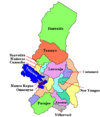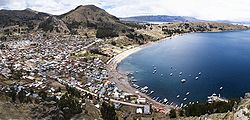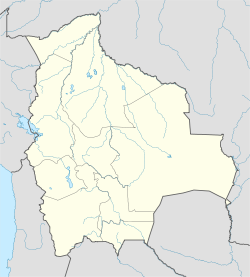- Copacabana, Bolivia
-
Copacabana — City — Panoramic view of Copacabana, at the shore of Lake Titicaca. Coordinates: 16°10′S 69°05′W / 16.167°S 69.083°W Country  Bolivia
BoliviaDepartament La Paz Department (Bolivia) Province Manco Kapac Province Municipality Copacabana Municipality Government - Mayor Area - City 346.5 km2 (133.8 sq mi) - Land 340.1 km2 (131.3 sq mi) - Water 6.4 km2 (2.5 sq mi) Elevation 3,841 m (12,602 ft) Population (2006) - City 6,000 - Density 358.5/km2 (928.5/sq mi) - Metro 703,771 Time zone EST (UTC-5) - Summer (DST) EDT (UTC-4) Area code(s) Area code 591 FIPS code 45-16000[1] GNIS feature ID 1245051[2] Website http://www.copacabana-bolivia.com Copacabana is the main Bolivian town on the shore of Lake Titicaca, from where boats leave for Isla del Sol, the sacred Inca island. The town has a large 16th-century shrine, the Basilica of Our Lady of Copacabana. Our Lady of Copacabana is the patron saint of Bolivia. The town is a destination for tourism in Bolivia. The town is also known for its famous Basilica, home of the Virgin of Copacabana, its trout, and its quaint atmosphere. Built between Mount Calvario and Mount Niño Calvario, the town has approximately 6,000 inhabitants. Copacabana's religious celebrations, cultural patrimony, and traditional festivals are well known throughout Bolivia.
Contents
Etymology
There is the belief that the name is derived from the Aymara kota kahuana, meaning "view of the lake." Nevertheless, the social scientist Mario Montaño Aragón, found in the "archives of Indias" in Sevilla, Spain, a completely different history: "Kotakawana" is the god of the fertility in the ancient Andean mythology, the equivalent to the classical Greek goddess Aphrodite or the Roman Venus. This god is androgyne and lives in the Titicaca, and his court consists of criters (male and female) that are represented in the colonial sculptures as in the Catholic churches they were called "Umantuus", known as mermaids in Western culture.
The fact is that the present Basilica was built where the main Temple of the Fertility of Kotakawana was once (nowadays there are small fertility temples along the shores of the lake in Bolivia and Peru). Copacabana has therefore been a Sacred place even before the Spanish conquest.
History
During the wars of independence, the Basilica of Our Lady of Copacabana was despoiled of most of its rich ornaments and gifts, and ruthless plundering by faithless custodians in the course of political disturbances has further contributed to impoverish it. The edifices, originally very handsome, are in a state of sad neglect. It is a shrine for pilgrims from Bolivia and southern Peru, and on 6 August the feast of its patron saint is frequented by thousands.
Before 1534 Copacabana was an outpost of Inca occupation among dozens of other sites in Bolivia. The Incas held it as the key to the very ancient shrine and oracle on the Island of Titicaca, which they had adopted as a place of worship, yielding to the veneration in which it stood among the Aymaras from time almost immemorial. There were at Copacabana minor shrines, in which the ceremonial of the Incas was observed with that of the original inhabitants. When the Spaniards first visited the Islands of Titicaca and Loati, in 1534 and 1538, the Andean Cosmovision were abandoned and the Dominicans made Copacabana the centre of their missions. Secular priests then replaced them at the instigation of the Viceroy Francisco de Toledo, and finally the mission and its annexes were entrusted to the Augustinians in 1589.
In 1582 the grandson of Inca ruler Manco Kapac, struck by the sight of the statues of the Blessed Virgin which he saw in some of the churches at La Paz, tried to make one himself, and after many failures, succeeded in producing one of excellent quality, and it was placed at Copacabana as the statue of the tutelar protectress of the community. Many miracles have been attributed to it, and its fame has spread far beyond the limits of its surroundings to all five continents. It is kept in a special chapel, where local Aymaras, Bolivians and those from all over the world are untiring in their devotions.
During the Great Indigenous Uprising of 1781, while the church itself was desecrated, the "Camarin", as the chapel is called, remained untouched and exempt from spoilation. Copacabana is the scene of often boisterous indigenous celebrations. On 2 February and 6 August, Church festivals are celebrated with indigenous dances that the clergy have not been able entirely to reform. Copacabana is surrounded by pre-Columbian ruins of considerable interest.
Gallery
References
- ^ "American FactFinder". United States Census Bureau. http://factfinder.census.gov. Retrieved 2008-01-31.
- ^ "US Board on Geographic Names". United States Geological Survey. 2007-10-25. http://geonames.usgs.gov. Retrieved 2008-01-31.
External links
- Semi-official Web page of Copacabana, Bolivia
- Weather in Copacabana
- "Copacavana". Catholic Encyclopedia. New York: Robert Appleton Company. 1913. http://www.newadvent.org/cathen/04350d.htm.
- Copacabana´s Tourist Information store The Spitting Llama Bookstore & Outfitter with links
- Bolivia Weekly Bolivia News
 La Paz Department
La Paz Department 
Capital: La Paz Provinces Abel Iturralde • Aroma • Bautista Saavedra • Caranavi • Camacho • Franz Tamayo • Gualberto Villarroel • Ingavi • Inquisivi • José Manuel Pando • Larecaja • Loayza • Los Andes • Manco Kapac • Murillo • Muñecas • Nor Yungas • Omasuyos • Pacajes • Sud Yungas

Municipalities
(and seats)Achacachi (Achacachi) • Achocalla (Achocalla) • Alto Beni (Caserío Nueve) • Ancoraimes (Ancoraimes) • Apolo (Apolo) • Aucapata (Aucapata) • Ayata (Ayata) • Ayo Ayo (Ayo Ayo) • Batallas (Batallas) • Cairoma (Cairoma) • Cajuata (Cajuata) • Calacoto (Calacoto) • Calamarca (Calamarca) • Caquiaviri (Caquiaviri) • Caranavi (Caranavi) • Catacora (Catacora) • Chacarilla (Chacarilla) • Charaña (Charaña) • Chulumani (Chulumani) • Chuma (Chuma) • Collana (Collana) • Colquencha (Colquencha) • Colquiri (Colquiri) • Comanche (Comanche) • Combaya (Combaya) • Copacabana (Copacabana) • Coripata (Coripata) • Coro Coro (Coro Coro) • Coroico (Coroico) • Curva (Curva) • Desaguadero (Desaguadero) • El Alto (El Alto) • Escoma (Escoma) • General Juan José Pérez (Charazani) • Guanay (Guanay) • Guaqui (Guaqui) • Huarina (Huarina) • Ichoca (Ichoca) • Inquisivi (Inquisivi) • Irupana (Irupana) • Ixiamas (Ixiamas) • Jesús de Machaca (Jesús de Machaca) • La Asunta (La Asunta) • La Paz (La Paz) • Laja (Laja) • Licoma Pampa (Licoma) • Luribay (Luribay) • Malla (Malla) • Mapiri (Mapiri) • Mecapaca (Mecapaca) • Mocomoco (Mocomoco) • Nazacara de Pacajes (Nazacara) • Palca (Palca) • Palos Blancos (Palos Blancos) • Papel Pampa (Papel Pampa) • Patacamaya (Patacamaya) • Pelechuco (Pelechuco) • Pucarani (Pucarani) • Puerto Acosta (Puerto Acosta) • Puerto Carabuco (Puerto Carabuco) • Puerto Pérez (Puerto Perez) • Quiabaya (Quiabaya) • Quime (Quime) • San Andrés de Machaca (San Andrés de Machaca) • San Buenaventura (San Buenaventura) • San Pedro de Curahuara (San Pedro de Curahuara de Carangas) • San Pedro de Tiquina (San Pedro de Tiquina) • Santiago de Callapa (Callapa) • Santiago de Huata (Santiago de Huata) • Santiago de Machaca (Santiago de Machaca) • Sapahaqui (Sapahaqui) • Sica Sica (Sica Sica) • Sorata (Sorata) • Tacacoma (Tacacoma) • Taraco (Taraco) • Teoponte (Teoponte) • Tiwanaku (Tiwanaku) • Tipuani (Tipuani) • Tito Yupanqui (Tito Yupanqui) • Umala (Umala) • Umanata (Umanata) • Viacha (Viacha) • Waldo Ballivián (Tumarapi) • Yaco (Yaco) • Yanacachi (Yanacachi)
Mountains Alpamayo Chico • Condoriri • Anallajsi • Ancohuma • Chachacomani • Chacaltaya • Illampu • Illimani • Huayna Potosí • MururataProtected areas Apolobamba • Cotapata • Madidi • Pilón Lajas
Categories:- Populated places in the La Paz Department, Bolivia
- Lake Titicaca
Wikimedia Foundation. 2010.






